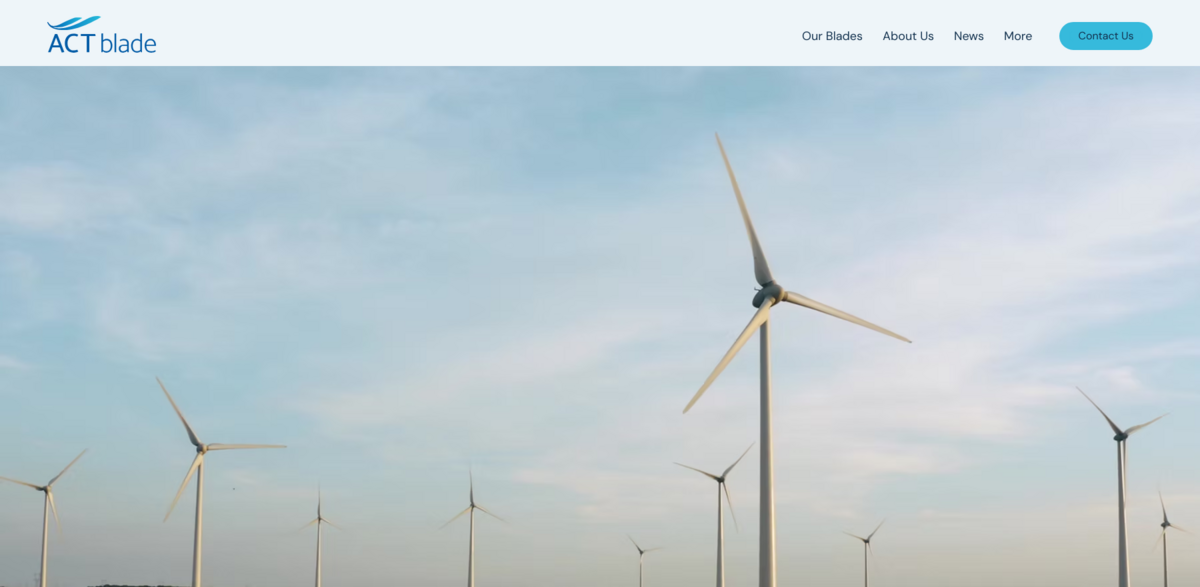The Next Generation of Wind Turbine Blade
ACT Blade Ltd develops the next generation of wind turbine blades – the ACT Blade project is setting new benchmarks in wind energy sustainability. The ACT blade technology is the lightest, most controllable, only modular and most sustainable wind turbine blade on the market. Made of an internal composite structure and fully covered by a highly engineered tensioned textile, the ACT Blade exploits aeroelastic science and innovative design to create efficiency akin to that seen in the world’s fastest yachts. This project is all about integrating smart design with sustainability in order to reshape wind energy, especially in remote areas and developing countries. It offers the possibility to create local content, stimulate jobs and develop new skills, all of which add to a dynamic approach to modern energy production… truly a leap forward.
Key Benefits and Metrics
The project delivers solid performance improvements that are hard to ignore. The design makes it possible to:
- 32% reduction in blade weight
- 10% longer blades
- 9% increase in energy production
- 7% reduction in the cost of energy
- 60% reduction in tooling costs
Each figure underlines the impressive improvements that ACT Blade brings to wind turbine efficiency and cost management, all while pushing the industry to a more sustainable approach.
Innovative Design and Engineering
The ACT Blade incorporates an internal composite structure fully enveloped by a tensioned textile, combining engineering precision with forward-thinking design. The solution isn’t just about making blades lighter – it’s about creating opportunities for longer blades with lower mass and the same mass-moment at the blade root. This clever approach helps produce more energy with minimal change in turbine loads, demonstrating a refined balance of performance and innovation. The design is protected by international patents and reflects more than 20 years of experience in marine innovation now translated into wind turbine solutions. It’s a design crafted with both efficiency and adaptability in mind… a true engineering marvel.
Enhanced Energy Production and Sustainability
Increasing wind energy production becomes even more feasible with the ACT Blade’s unique manufacturing process. Its lower weight allows for longer blades to be built at lower mass, directly leading to an increase in energy output by over 9%. Moreover, the modularity of the design enables production through existing supply chains, simplifying and speeding up assembly processes. This not only helps in reducing capital costs by up to 45% but also ensures the blades are more sustainable by being partly recyclable and incorporating recycled materials—ultimately reducing landfill waste and aligning with an eco-friendly approach. In essence, the ACT Blade opens up exciting opportunities for remote regions and emerging markets, where local skills and job creation become an added benefit alongside energy production.
Advanced Technology and Manufacturing
At its core, the ACT Blade is not simply a new component—it represents a technological step forward in the harnessing of wind power. The combination of a composite structure with a tensioned textile covering creates a blade that is not only lighter and longer, but also incredibly controllable and versatile. The technology drives a modular manufacturing process that allows for easier, cost-effective production and faster assembly. This component-based design means the blades can be retrofitted onto existing turbines, such as the ACT100, a 49.2m long blade for 2MW turbines. The ability to retrofit and extend the operational life of wind farms significantly boosts the economics of renewable energy projects, thus ensuring that the project maintains a competitive edge in an evolving market.
Global Competitiveness and Market Impact
The impact of ACT Blade goes beyond just technical specifications. It positions itself as a game changer in the renewable energy sector by contributing toward displacing 274k tons of CO2 emissions from conventional power generation. With a projected increase in wind energy production of 937 GWh by 2030, the technology stands to make a noticeable dent in the overall EU target towards cleaner energy. This progress in blade technology also emphasizes the trend towards more sustainable practices across industries. Collaborations with leading industry players and European research centres have further cemented its reputation, as evidenced by prestigious acknowledgments such as the G20 Innovation Award and the EIT Public Award. The project resonates with future-focused, environmentally responsible energy production.
Project Impact on Sustainable Development Goals
- SDG 7: Affordable and Clean Energy
- SDG 8: Decent Work and Economic Growth
- SDG 9: Industry, Innovation, and Infrastructure
- SDG 13: Climate Action
A Future-Focused Vision for Wind Energy
The ACT Blade project encapsulates a forward-thinking vision for wind energy—a blend of sustainability, efficiency, and market adaptability. By leveraging advanced design that utilizes lighter materials and innovative construction techniques, it furnishes wind farms with the ability to boost energy output and prolong their operational life. The technology’s modularity ensures that it can be seamlessly integrated with current manufacturing practices, paving the way for widespread adaptation, especially in regions where expanding wind energy production is vital. With over 20 years of innovation history backing its developments, ACT Blade stands as a symbol of tomorrow’s renewable energy landscape, tying in technical ingenuity with environmental responsibility. It’s a dynamic step that not only meets today’s energy demands but is also finely tuned for the future—a future where sustainability meets competitive efficiency, driving the global transition toward net-zero emissions and a cleaner, safer planet.





















